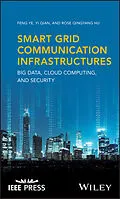A comprehensive resource that covers all the key areas of smart grid communication infrastructures
Smart grid is a transformational upgrade to the traditional power grid that adds communication capabilities, intelligence and modern control. Smart Grid Communication Infrastructures is a comprehensive guide that addresses communication infrastructures, related applications and other issues related to the smart grid. The text shows how smart grid departs from the traditional power grid technology. Fundamentally, smart grid has advanced communication infrastructures to achieve two-way information exchange between service providers and customers.
Grid operations in smart grid have proven to be more efficient and more secure because of the communication infrastructures and modern control. Smart Grid Communication Infrastructures examines and summarizes the recent advances in smart grid communications, big data analytics and network security. The authors - noted experts in the field - review the technologies, applications and issues in smart grid communication infrastructure. This important resource:
* Offers a comprehensive review of all areas of smart grid communication infrastructures
* Includes an ICT framework for smart grid
* Contains a review of self-sustaining wireless neighborhood that are network designed
* Presents design and analysis of a wireless monitoring network for transmission lines in smart grid
Written for graduate students, professors, researchers, scientists, practitioners and engineers, Smart Grid Communication Infrastructures is the comprehensive resource that explores all aspects of the topic.
Autorentext
FENG YE, Assistant Professor, Department of Electrical and Computer Engineering, University of Dayton, USA.
YI QIAN, Professor, Department of Electrical and Computer Engineering, University of Nebraska-Lincoln (UNL), USA.
ROSE QINGYANG HU, Professor, Department of Electrical and Computer Engineering, Utah State University, USA.
Inhalt
1 Background of the Smart Grid 1
1.1 Motivations and Objectives of the Smart Grid 1
1.1.1 Better Renewable Energy Resource Adaption 2
1.1.2 Grid Operation Efficiency Advancement 3
1.1.3 Grid Reliability and Security Improvement 4
1.2 Smart Grid Communications Architecture 5
1.2.1 Conceptual Domain Model 6
1.2.2 Two-Way Communications Network 7
1.3 Applications and Requirements 9
1.3.1 Demand Response 9
1.3.2 Advanced Metering Infrastructure 10
1.3.3 Wide-Area Situational Awareness and Wide-Area Monitoring Systems 11
1.3.4 Communication Networks and Cybersecurity 12
1.4 The Rest of the Book 13
2 Smart Grid Communication Infrastructures 15
2.1 An ICT Framework for the Smart Grid 15
2.1.1 Roles and Benefits of an ICT Framework 15
2.1.2 An Overview of the Proposed ICT Framework 16
2.2 Entities in the ICT Framework 18
2.2.1 Internal Data Collectors 18
2.2.2 Control Centers 20
2.2.3 Power Generators 22
2.2.4 External Data Sources 23
2.3 Communication Networks and Technologies 23
2.3.1 Private and Public Networks 23
2.3.2 Communication Technologies 24
2.4 Data Communication Requirements 30
2.4.1 Latency and Bandwidth 31
2.4.2 Interoperability 32
2.4.3 Scalability 32
2.4.4 Security 32
2.5 Summary 33
3 Self-Sustaining Wireless Neighborhood-Area Network Design 35
3.1 Overview of the Proposed NAN 35
3.1.1 Background and Motivation of a Self-Sustaining Wireless NAN 35
3.1.2 Structure of the Proposed NAN 37
3.2 Preliminaries 38
3.2.1 Charging Rate Estimate 39
3.2.2 Battery-Related Issues 40
3.2.3 Path Loss Model 42
3.3 Problem Formulations and Solutions in the NAN Design 44
3.3.1 The Cost Minimization Problem 44
3.3.2 Optimal Number of Gateways 48
3.3.3 Geographical Deployment Problem for Gateway DAPs 51
3.3.4 Global Uplink Transmission Power Efficiency 54
3.4 Numerical Results 56
3.4.1 Evaluation of the Optimal Number of Gateways 56
3.4.2 Evaluation of the Global Power Efficiency 56
3.4.3 Evaluation of the Global Uplink Transmission Rates 58
3.4.4 Evaluation of the Global Power Consumption 59
3.4.5 Evaluation of the Minimum Cost Problem 59
3.5 Case Study 63
3.6 Summary 65
4 Reliable Energy-Efficient Uplink Transmission Power Control Scheme in NAN 67
4.1 Background and Related Work 67
4.1.1 Motivations and Background 67
4.1.2 Related Work 69
4.2 System Model 70
4.3 Preliminaries 71
4.3.1 Mathematical Formulation 72
4.3.2 Energy Efficiency Utility Function 73
4.4 Hierarchical Uplink Transmission Power Control Scheme 75
4.4.1 DGD Level Game 76
4.4.2 BGD Level Game 77
4.5 Analysis of the Proposed Schemes 78
4.5.1 Estimation of B and D 78
4.5.2 Analysis of the Proposed Stackelberg Game 80
4.5.3 Algorithms to Approach NE and SE 84
4.6 Numerical Results 85
4.6.1 Simulation Settings 85
4.6.2 Estimate of D and B 86
4.6.3 Data Rate Reliability Evaluation 87
4.6.4 Evaluation of the Proposed Algorithms to Achieve NE and SE 88
4.7 Summary 90
5 Design and Analysis of a Wireless Monitoring Network for Transmission Lines in the Smart Grid 91
5.1 Background and Related Work 91
5.1.1 Background and Motivation 91
5.1.2 Related Work 93
5.2 Network Model 94
5.3 Problem Formulation 96
5.4 Proposed Power Allocation Schemes 99
5.4.1 Minimizing Total Power Usage 100
5.4.2 Maximizing Power Efficiency 101
5.4.3 Uniform Delay 104
5.4.4 Uniform Transmission Rate 104
&...